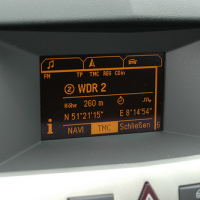In early 2013, General Motors announced that it was partnering with AT&T to start providing 4G LTE internet in cars, beginning with its 2015 models. This is the most widespread integration of LTE internet into cars so far, but does it mean you’re soon going to be surfing the internet in the middle of traffic? And who exactly thinks that’s a safe idea?
The issue is a bit more complicated than it seems. Internet in the car is a result of cell phone companies looking for new growth, since the mobile market is so saturated and everybody has a phone.
AT&T is providing this internet service through OnStar, which many GM cars already feature. It’s an optional upgrade, and it will come with a monthly service charge just like a regular internet subscription. Whether this new LTE trend will continue to be for a select few or become even more widespread is something nobody is exactly sure of.
1. The Many Uses of LTE in Cars
When you think of having the internet in your car, you might imagine browsing websites or entertaining the kids on long road trips, but it can potentially do much more than that. In its defense, 4G internet speeds in your car will allow for for better driving and vehicle performance. As you drive, your car’s computer can download safety enhancements, check for mechanical problems, and even display real-time traffic and road condition information on your dashboard.
Of course, you can also access Facebook, Netflix, and other websites on up to 8 devices, essentially turning your vehicle into a wifi hotspot on wheels. GM has declared that LTE will reinvent the driving and riding experience, and in the future, designers will come up with apps for the car instead of just the mobile phone. But whether consumers really want to pay for a service many still see as frivolous remains to be seen.
2. How Safe Is It?
Naturally, the number one concern with providing internet in cars is distracted driving. In an age where more than 80 percent of drivers admit to having texted behind the wheel, the inherent danger of turning a vehicle into a computer is obvious. But GM specifically is working with the National Highway Traffic Safety Administration to combat this issue, ensuring that apps which don’t meet their standards will be unavailable for access while the car is moving.
GM’s theory is that distracted driving is already so prevalent, drivers will simply be better off with their safer system designed in collaboration with the NHTSA. Not only that, LTE internet is the first step towards greater car-to-car communication, which could one day lead to cars that drive themselves. Nobody will have to worry about distracted driving when they’re working out of their car as it navigates through traffic jams for them.
3. How Do You Get It?
A surprising number of cars will be equipped with LTE possibilities starting next year, including most Chevrolet, Buick, GMC, and Cadillac models. Brands like BMW and Audi have already begun rolling out this technology, but this is the first time it will be so commonly available. There will be a variety of packages for customers to choose from, depending on what they need from their LTE and what they’re willing to pay for, and just like the OnStar service, GM is discussing a 2-month free trial period.
The car it fitted with a built-in router that provides a signal using the same technology as cell phones, which is also why many opponents are skeptical that it will catch on. With so many driving apps and the ability to sync your smartphone with your car, selling the benefits of an internet connection provided by the car might be difficult. But unlike phones, you won’t have to buy a new one every time the technology improves. You’ll simply take your car to the dealership for an upgrade.
In the end, LTE internet in vehicles is a matter of personal choice. Many tech-savvy drivers will be amazed by the number of things you can do with 4G speeds and in-car apps, while more pragmatic car owners will wait to see if this technological revolution is everything GM hopes it will be. But it’s one more step towards a world where consumers are online 24 hours a day, and that’s why, in a way, the implications are significant, even if the public’s embrace is slow. It’s definitely a fascinating look at where technology will take the future.
Author Amy Thomson blogs for Monkey.co.uk insurance. Interested in new car technology? Check out her other articles at Twitter @VroomVroomAmy.


